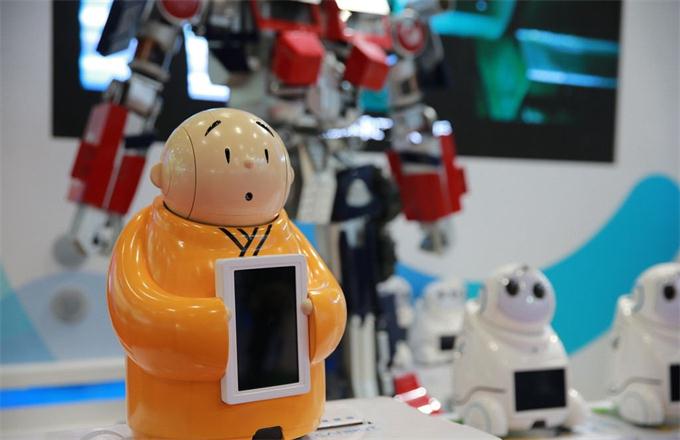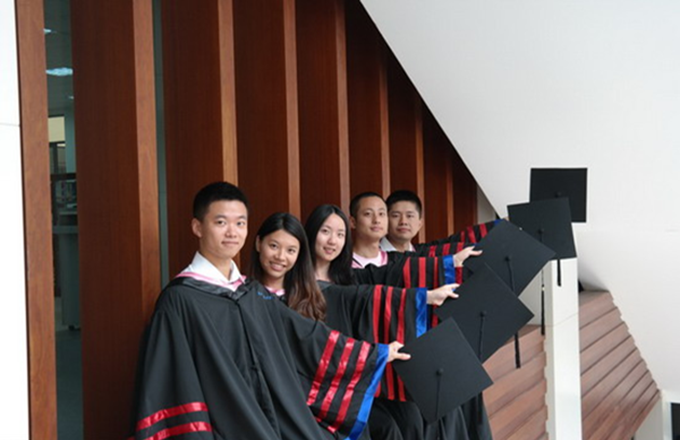Media has responsibility to tell China's story
 |
|
Minister Jiang Jianguo (second from right) opens the "Beautiful China, Beautiful Switzerland" photo exhibition in Geneva, on Wednesday. [Photo/Xinhua] |
First, China's economic development still enjoys a bright future. China's economy has entered a new normal in which its growth has decelerated and its annual growth rate has slowed to between 6.5 and 7 percent. Despite its slower growth rate, given that its economic aggregate has exceeded $10 trillion, China's newly created economic output every year will still be tantamount to that of a middle-sized country if maintained. Now, China's economy is within a reasonable growth range and the country is refraining from pursuing fast economic growth in favor of more-sustainable growth. That has helped China ease its previously strained supply-demand relations and mitigated the heavy burden on its resources and environment. The health of the country's finance guarantees normal economic operations, and with its stable society the country has been able to mobilize all its available resources to advance its economic structural adjustments. Here I would like to offer some data to demonstrate the tangible achievements made by China in its bid for economic structural adjustments. The growth of the service sector meant that in the first three quarters of 2016 it contributed 58.5 percent to China's national economy, and it became a major engine of the country's economic growth. Consumption contributed 71 percent to the growth of China's gross domestic product and its role in this regard has further risen; emerging industries of strategic importance and the high-tech sectors have maintained an average growth of more than 10 percent.
 |
| China Daily |
But some problems that had previously been covered up during China's high-speed development are now looming large, including the outstanding contradiction between the overcapacity in production and the trend to upgrade the structure of demand, the insufficiency of consumption as an intrinsic driving force for economic growth, the accumulation of financial risks and increased difficulties facing some regions. In particular, China's real economy is not solid enough, while its digital economy is a little weak, and the trend has emerged that more and more resources are flowing from the real economy to the digital economy. The Chinese government attaches high importance to these problems, but it believes these problems are manageable, their risks controllable and the underlying factors resolvable, and it is deepening reform to promote their fundamental settlement. China has the confidence and the capability to brave the storms, overcome the obstacles, and continue forward toward the bright prospects ahead.
Second, China's economic development has brought the world great opportunities. Over the course of its rapid development, there have been people who have believed that China has got a free ride from other countries. Objectively speaking, who can give a free ride to China, given its size? Instead, what China has done is work together with other countries to push the "world's wagon" forward and welcomed other countries to have a free ride on its development.
China is a country of a colossal size and by itself is a "world". Over the past decades, China's fast economic development has mainly taken place in its eastern regions, especially its coastal regions, and its vast central and western regions are still relatively undeveloped and are yet to expedite development. The phenomenon of both developed and less-developed economic conditions coexisting in China decides that the country is becoming a major "buyer" and an important "investor" in the global market. In the coming five years, China's import volume is expected to be $8 trillion and it is predicted there will be 700 million outbound visits. China is also expected to utilize $600 billion in terms of foreign capital and its outbound investment will reach $750 billion. These mean China will offer the rest of the world a broad market and more opportunities for cooperation.
China began building the Great Wall in the Qin Dynasty (221-206 BC) to fend off foreign enemies. It began establishing the Silk Road in the Han Dynasty (206 BC-220) to build links with the outside world. Today, China is not rebuilding the Great Wall; it is recreating the Silk Road.
China has launched the Belt and Road Initiative (the Silk Road Economic Belt and the 21st Century Maritime Silk Road) and the Asian Infrastructure Investment Bank, established a BRICS bank, and set up a fund to support South-South cooperation among other public goods in the development field. For years, China has offered least-developed countries preferential trade treatment and imposed zero tariffs on their goods. China has continuously increased foreign aid and voluntarily reduced the debt owed by developing countries or promoted its exemption. All these have offered significant opportunities for the development of a number of emerging economies and developing countries.
Third, China's economic development has made important contributions to the world. Since the outbreak of the global financial crisis, China's sound and stable economy has consistently remained a stabilizer for the world economy. From 2008 to 2015, China contributed nearly 40 percent of global GDP growth. The International Monetary Fund has estimated that China contributed 39 percent of global economic growth in 2016, 1.5 times that of all the developed countries combined.
In terms of innovation-driven growth, China is gradually assuming a global role. In 2015, China submitted more than 1 million patent applications, ranking top in the world. At the G20 Hangzhou Summit, China pushed for the inclusion of "innovation" in the summit's theme and coordinated the formulation of a blueprint of G20 innovation-driven growth along with other outcome documents. Just as an article in The Economist pointed out, China was a recipient of the world's innovation fruits in the past, but a number of Chinese enterprises are now universally recognized as leaders of world innovation.
Especially in the past 30-plus years China has successfully lifted more than 700 million people out of poverty, accounting for 70 percent of the world's total population extricated from poverty and realizing the fastest large-scale poverty-alleviation campaign ever seen. China has carefully fulfilled the UN Framework Convention on Climate Change, and is the first country to formulate a national program to deal with climate change. During the 12th Five-Year Plan (2011-15) period, China's carbon dioxide emissions per unit of GDP declined by 20 percent, completing 117.6 percent of the set goal.
Dear friends, over the recent years, China's economy has encountered numerous risks and challenges but also reaped various successes and joys. China's economy has become the "ballast" for global economic stability and a driver of global economic development, and it is playing an increasingly important and irreplaceable role in global economic governance. The reason is that under the leadership of President Xi, China has formed a series of concepts on economic governance based on its development experience and current national conditions that provide rich theoretical resources and policy guidance for its economic practices. President Xi's economic concepts for governance can be generally categorized as follows:
First: adhering to people-centered development. To adhere to such a principle and enhance people's well-being is the fundamental start point and also end point for the Communist Party of China to govern the nation and develop the Chinese economy. President Xi has stressed many times that China's development is for the people and depends on the people, and that its development fruits are to be shared by the people. China adheres to people-centered development to create new growth areas and raise long-term growth potential in its efforts to resolve the outstanding problems that concern people the most.
Second: adapting to the new normal and guiding it. A few years ago, President Xi made a significant strategic judgment that China's economic development had entered the new normal. The new normal means China's economy has shifted from high-speed growth to a medium-speed growth, its economic development mode has shifted its focus from speed and scale-prioritized extensive growth to quality and efficiency-focused intensive growth, its economic structure has made deep adjustments for better optimization, and its economic development dynamic has shifted from the traditional growth dynamic to a new growth dynamic. The new normal offers a logical starting point for people to understand China's current economic situation.
Third: adhering to new development concepts. Targeted at some outstanding problems and contradictions that have emerged at a time when China's economy has entered a new normal, President Xi has put forward "innovative, coordinated, green, open and shared" development concepts, which respectively focus on resolving the problems of the driving force for development, imbalanced development, sustainable and environmentally friendly development, internal and external interconnection, as well as social equity and justice. With these development concepts as guidance, China is combining an effective market and a well-functioning government to implement a series of major reforms.
Fourth: taking supply-side structural reform as the priority. As a top priority of its economic development, China must overcome its major structural imbalance and realize a dynamic equilibrium in its supply-demand relationship. Hence, President Xi has stressed that China should take supply-side structural reform as the main line for its economic development. To this end, China has confirmed five policy pillars, which can be vividly likened to "firing five guns at a bird". In recent years, China has conducted supply-side structural reforms involving the implementation of the Belt and Road Initiative, coordinated development of the Beijing-Tianjin-Hebei region and the development of the Yangtze River Economic Belt, as well as people-centered urbanization, an energy revolution and the expansion of the middle-income group. All these are helping to realize the gradual transformation of the economy and achieve sustainable growth.
A powerful force, reforms can push economic growth.
Fifth: adhering to the pursuit of advancement while maintaining stability. President Xi has put forward the general tone of pursuing advancement while maintaining stability, which offers guidance for China's economic development in terms of policy and effects. In terms of policy, China will maintain macro policy stability and in terms of effects it will strive to stabilize market expectations to enhance entrepreneurs' confidence and boost government credibility. Under the precondition of "stability", China will keep forging ahead in key areas and ambitiously act after well-managing the "degree". "Stability" and "advancement" should be an organic combination and mutually promoting.
Dear friends, China has strong confidence in its road, theory, system and culture. Persons of insight across the world have acknowledged the end of such fallacies as "China's collapse" and "the end of history" regarding China's development. But China will not feel complacent and overconfident, it will strive to make new discoveries, new inventions, new creations, and new advancements, and in particular seek to make new contributions to humankind. Mr. Sun Yat-sen said 93 years ago that "China still needs to take big responsibility for the world". Chairman Mao Zedong said 61 years ago that "China should make relatively big contributions to mankind". Paramount leader Deng Xiaoping said 31 years ago that "China can do more things for mankind". Now President Xi has said that "China is always a builder of world peace, a contributor to global development and a maintainer of the international order".
While following the edifications from past and current leaders, Chinese people also ponder what new contributions China can make to the world. Everyone belongs to one family that lives on one planet, and as President Xi has said: "The Chinese people not only hope for a good life for ourselves, we also wish a good life for people in other countries". In today's China, comprehensive reforms are being deepened, the economy continues to develop, society remains harmonious and stable, people's livelihoods are continuously improving and people live and work in peace. Reform, development and stability are what the world desperately needs, but they are "rare luxuries" today. Hence, China will unselfishly contribute its successful experiences and action programs, and actively encourage international society to join hands and hold fast to the principle of forging a community of shared destiny for all humankind. It will vigorously advocate the concepts of "consultation, common construction and sharing" in global economic governance, resolutely discard unilateralist, monopolistic and exclusive behavior, push for economic globalization, and build a community of shared destiny for all humankind featured as "I am part of you, you are part of me, we are in the same boat, and we pull together in times of trouble", in a bid to make our planet a more peaceful and prosperous one.
Dear friends, an important duty of the State Council Information Office of the People's Republic of China, where I work, is to promote exchanges and cooperation between the Chinese and foreign media. In the future, we are willing to make continuous efforts with all of you to actively offer more convenience and create better conditions for our media exchanges and cooperation.
As a Chinese saying goes, "it is better to see once than to hear a hundred times". You are welcome to come to China to take a walk and have a look around, and to engage in more dialogue and cooperation with the Chinese media to enhance mutual understanding and enhance friendships so that we can jointly push for a better-developed and more prosperous China-Switzerland relationship.
Thank you!

























